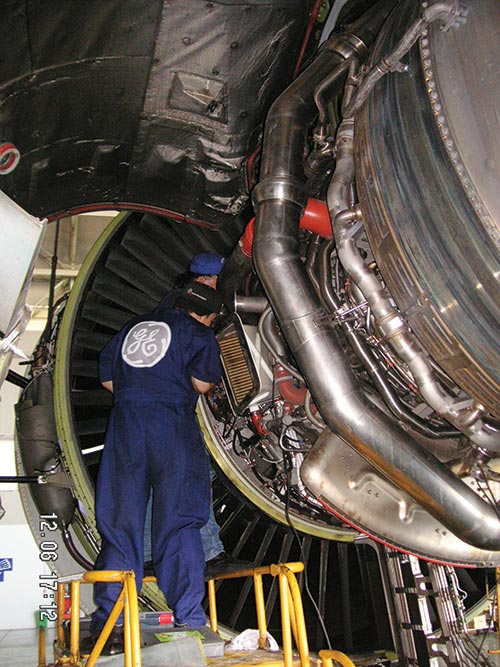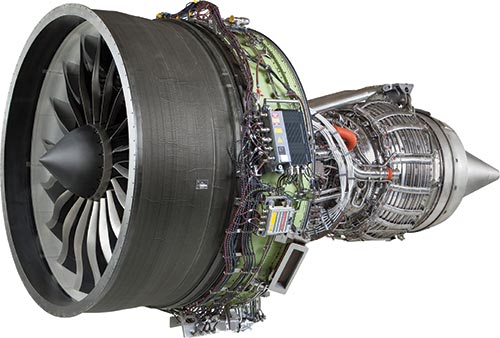GE’s hi-tech supports Vietnam’s burgeoning aviation industry

The greatest value in buying GE’s engines is the training provided by the company’s engineers
Starting from humble beginnings, Vietnam Airlines and VietJet Air are expanding their aircraft fleets and gaining valuable technical experience in operating the world’s most modern jet aircraft. Along the journey, they are also bolstering their relationships with the US’ GE Aviation, the world’s largest producer of jet engines.
Over the next several years, the GE jet engine fleet operating out of Vietnam is expected to more than double. The strong alliance between GE Aviation and these growing airlines will contribute significantly to the nation’s goal to become one of the Pacific region’s leading business and tourist destinations.
VietJet Air already operates 15 single-aisle Airbus A320 aircraft, powered by CFM56 engines produced by CFM International, a joint company of GE and Safran of France. VietJet also has another 21 CFM-powered A320/A321 and 42 A320neo aircraft on order. The best-selling CFM56 engine is the propulsion workhorse of the airline industry, powering most single-aisle airplanes. The teams are well-prepared to manage the airlines’ expanding CFM56 engine fleet.
Several years ago, Vietnam Airlines began leasing Boeing 777 aircraft powered by the GE90 engine, the world’s largest and most powerful jet engine. As Vietnam has become a popular air-travel destination, the 777 fleet has enabled Vietnam Airlines to successfully establish popular flights to Paris from Hanoi and Ho Chi Minh City.
In 2015, Vietnam Airlines plans to take a bold step forward when it receives the first of its 19 Boeing 787-9 Dreamliner aircraft, powered by GE’s new GEnx jet engine. The GEnx, among the world’s most fuel efficient engines, is also the world’s only jet engine to feature a carbon fiber front fan system and other unique technology features. From the front to back, the GEnx is among the world’s most sophisticated jet engines on the all-electric powered 787 aircraft. As with the GE90 engine fleet, the new GEnx creates a significant learning opportunity for the Vietnam Airlines technical teams.
GE Aviation will provide both the engines’ and the aircraft system’s common core computing system for Vietnam Airlines’ 787s, and soon, the airline technical teams will be trained on both. In addition, GE will conduct various simulated “stress tests” with the airline to ensure that the carrier’s personnel are adequately prepared to manage any operational challenges.
“When an airline selects GE engines, it is like entering into a marriage because it is a very long-term relationship,” said Andrew Carlisle, GE’s regional general manager covering Vietnam. “There is considerable training and preparation of the airline crews on our complex equipment. GE becomes aligned with the airline’s goals and aspirations. The relationship between GE and the air carriers of Vietnam is expanding quickly, and we are excited about our future together.”

Vietnam Airlines is applying GE’s GEnx engines to its Dreamliner fleet
The relationship between GE and Vietnam’s airlines extends beyond training on the flight line. Leadership from both VietJet Air and Vietnam Airlines have attended classes at GE’s Global Customer Summits held in GE’s storied training centre in Crotonville, New York, near New York City. In late September, GE vice chairman John Rice hosted an alumni dinner in Hanoi for past Vietnamese graduates of this programme including attendees from Vietnam Airlines and VietJet Air.
“Modern air-travel systems are critical to economic growth,” said Carlisle. “Vietnam is advancing quickly and the arrival of new jetliners will enhance an important in-country technical capability. GE is thrilled to be part of this historic development. This is an exciting time to be part of aviation in Vietnam.”
| GE’s hi-tech to enhance flight efficiency The GEnx engine is a giant step forward in propulsion technology. Using new materials and design processes to reduce weight, improve performance and lower maintenance needs, the engine consumes 15 per cent less fuel than its predecessor, making it both economical and environmentally-friendly. It is the world's first commercial jet engine with a fan case and other parts made of carbon fibre composites, which are more durable and easier to maintain than parts in previous models. While expanding its partnerships with Vietnamese airlines to deliver jet engines, GE Aviation also wants to distribute its new technological solutions to help them enhance their efficiency, including Performance-Based Navigation (PBN). This technology allows pilots to use on-board technology to follow a precise track, independent of ground-based navigation beacons that limit the aircraft’s route. Required Navigation Performance (RNP) procedures, an advanced form of PBN technology, can be designed to shorten an aircraft’s route and to reduce fuel consumption, exhaust emissions and noise pollution in communities near airports. In 2012, Malaysia’s AirAsia, the leading and largest low-cost carrier in Asia, tasked GE Aviation with the design and implementation of the world’s first network of International Civil Aviation Organization’s (ICAO) Required Navigation Performance Authorization Required (RNP AR) flight paths, the highest-performing type of PBN procedures. The programme encompassed the development of GE-designed and ICAO9905-compliant RNP AR approach paths for 15 Malaysian airports. The high-precision flight paths will improve AirAsia’s operational efficiency by reducing track miles and fuel consumption and providing aircraft with guidance for precise lateral and vertical arrival and missed approaches. |
The next issue, to be published on November 10, will feature an article on GE’s contribution to healthcare services in Vietnam and show how GE’s innovative technologies are helping to improve the lives of patients and reduce medical expenses.
What the stars mean:
★ Poor ★ ★ Promising ★★★ Good ★★★★ Very good ★★★★★ Exceptional
Latest News
More News
- Addressing Vietnam's energy challenges with aeroderivative gas turbines (February 28, 2023 | 09:33)
- How to sprint ahead in 2023’s worldwide energy priorities (February 08, 2023 | 13:55)
- Boosting Vietnam's grid stability through gas turbine technology (November 22, 2022 | 20:02)
- Healthcare trio collaborates to provide thousands of free breast scans (October 27, 2022 | 17:19)
- GE Healthcare's vision for AI-backed radiology (September 29, 2022 | 11:53)
- GE brand trio to shape the future of key industries (July 19, 2022 | 15:35)
- GE unveiling brand names and defining future (July 19, 2022 | 15:16)
- GE: the shortest route towards sustainability (July 18, 2022 | 08:00)
- Be proactive in an uncertain world (May 20, 2022 | 11:40)
- GE secures first 9HA combined cycle power plant order in Vietnam (May 16, 2022 | 17:06)

















 Mobile Version
Mobile Version